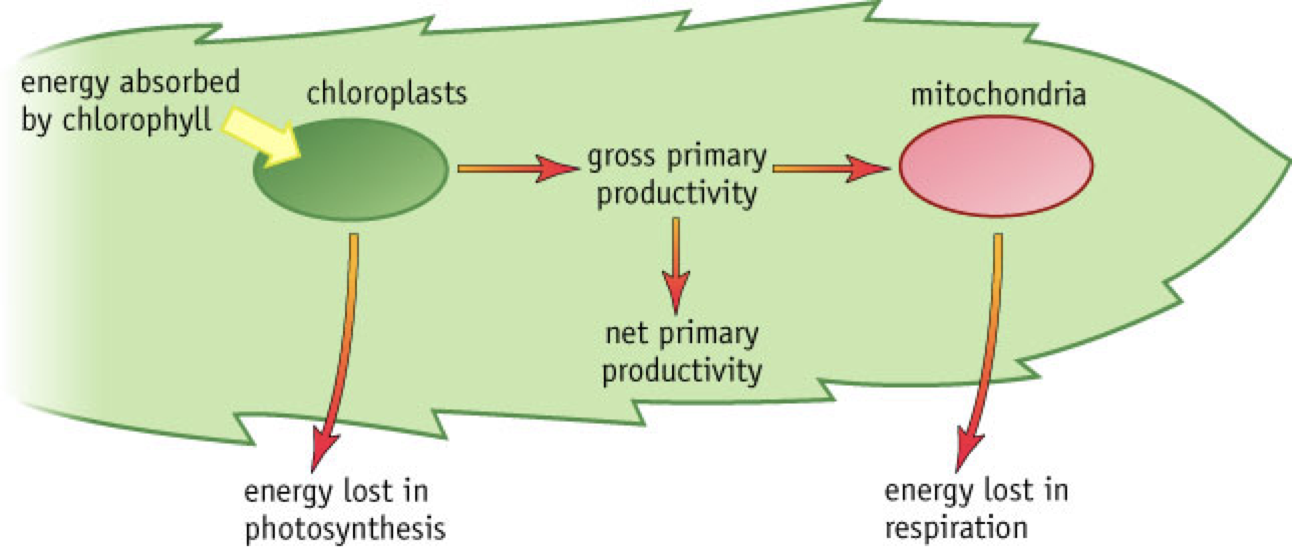6.3.1(b) biomass transfers through ecosystems
spec points
the efficiency of biomass transfers between trophic levels
efficiency = biomass transferred/biomass intake x 100
how human activities can manipulate the transfer of biomass through ecosystems.
efficiency of energy transfers
very large proportion of Sun's energy isn’t made available to photosynthetic plants, because
Light falls away from plants
Light passes through leaves or is reflected away
Light is a mixture of wavelengths, and only certain wavelengths stimulate photosynthesis
During photosynthesis, primary producers such as plants and algae convert light energy to chemical energy in biological molecules
The storing of this chemical energy as plant biomass makes a certain amount of energy available to the next trophic level, the primary consumers
Only a small percentage of plant biomass becomes biomass in the primary consumer because:
Not all the plant's biomass is eaten by the primary consumer
Not all the consumer's biomass intake is digested
Think about the energy content of cow dung, which can be dried and used as a heating/cooking fuel, as it contains a lot of undigested biomass e.g. cellulose
The primary consumer converts a lot of chemical energy to movement and heat, and only a small amount to new biomass in its own body
The efficiency of biomass transfer from one trophic level to the next is low, typically around 10%
Scientists use 3 calculations for measuring plant productivity in ecosystems:
Primary productivity
GPP
NPP
primary, gross, and net primary productivity
primary productivity measures energy produced by photosynthetic organisms in ecosystem
gross primary productivity: measures total amount of organic matter produced by photosynthetic organisms in ecosystem. Plants also use some of matter they produce for respiration. Remainder is available for heterotrophs

net primary productivity (NPP): measures amount of matter produced that is available for heterotrophs. NPP for ecosystem is generally measured in grams per square meter (g/m2)

net primary productivity (NPP): rate which energy is transferred into organic molecules that make up new plant biomass, that is the chemical energy store in plant biomass after respiratory losses to the environment have been taken into account
NPP = GPP - R
GPP = gross primary productivity
R = respiratory losses
gross primary productivity (GPP): rate at which energy is incorporated into organic molecules in the plants in photosynthesis, that is the chemical energy store in plant biomass, in given area/volume, in given time
thus NPP = GPP - R
net primary production is available for plant growth + reproduction as well as to other trophic levels in ecosystem ex. decomposers + herbivores
net production of consumers (N) such as animals can be calculated by N = I - (F+R) where:
I = chemical energy store in ingested food
F = chemical energy lost to environment in faeces + urine
R = respiratory losses to environment
how can human activities can manipulate the transfer of biomass through ecosystems
Human activity can adjust the efficiency of transfer of biomass between trophic levels, usually to maximise it in the context of maximising agricultural productivity
For producers, arable farmers can adopt these methods
Providing artificial light in greenhouses on overcast days
Optimising planting distances between crops
Irrigation to maximise growth in dry weather
Use of fertilisers
Selective breeding for fast growth
Use of fungicides/pesticides
Fencing to exclude grazers
Ploughing and herbicides to kill weeds
Plant crops that store energy in edible form e.g. seeds, fruit, tubers
Livestock farmers can adopt these methods for primary consumers (grazers)
Use of good quality feeds / food supplements
Use antibiotics and vaccines to reduce disease
Control predation with fencing or with indoor animal husbandry
Reduce competition for grazing e.g. rabbits, deer
Indoor husbandry to reduce energy loss from movement or from getting cold outside